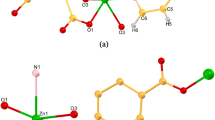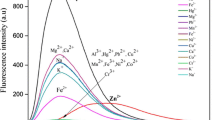Abstract
A terbium(III)-functionalized zinc(II)-organic framework (Tb-MOF-Zn) is shown to be a viable fluorescent probe for phosphate. The organic ligands 4,4′,4″-[((2,4,6-trimethylbenzene-1,3,5-triyl)tris(methylene))tris(oxy)]tribenzoic acid (H3L3) contains multiple carboxyl groups that can react with zinc(II) to yield tubular MOF-Zn. The MOF-Zn was further functionalized with Tb(III) to produce a lanthanide composite of type Tb-MOF-Zn which displays strong fluorescence with excitation/emission maxima at 285/544 nm. Fluorescence is quenched by phosphate because of the specific interaction with Tb(III) in Tb-MOF-Zn. The concentration of Tb-MOF-Zn, reaction time and pH value of the solution were optimized. Fluorescence drops linearly in the 0.01 to 200.0 μM phosphate concentration range, and the detection limit is 4.0 nM. The fluorescent probe was also used to prepare a microdot array on a glass slide for visual detection of phosphate under illumination with UV light.

A terbium(III) functionalized zinc(II)-organic framework was synthesized and used as fluorescent probe for determination of phosphate ions.






Similar content being viewed by others

References
Cheng WL, Sue JW, Chen WC, Chang JL, Zen JM (2010) Activated nickel platform for electrochemical sensing of phosphate. Anal Chem 82:1157–1161
Wygladacz K, Qin Y, Wroblewski W, Bakker E (2008) Phosphate-selective fluorescent sensing microspheres based on uranyl salophene ionophores. Anal Chim Acta 614:77–84
Yang J, Dai Y, Zhu X, Wang Z, Li Y, Zhuang Q, Shi J, Gu J (2015) Metal-organic frameworks with inherent recognition sites for selective phosphate sensing through their coordination-induced fluorescence enhancement effect. J Mater Chem A 3:7445–7452
Ahmad R, Ahn MS, Hahn YB (2017) ZnO nanorods array based field-effect transistor biosensor for phosphate detection. J Colloid Interface Sci 498:292–297
Mak WC, Chan C, Barford J, Renneberg R (2003) Biosensor for rapid phosphate monitoring in a sequencing batch reactor (SBR) system. Biosens Bioelectron 19:233–237
Liu W, Du Z, Qian Y, Li F (2013) A specific colorimetric probe for phosphate detection based on anti-aggregation of gold nanoparticles. Sensors Actuators B Chem 176:927–931
Zhao HX, Liu LQ, Liu ZD, Wang Y, Zhao XJ, Huang CZ (2011) Highly selective detection of phosphate in very complicated matrixes with an off-on fluorescent probe of europium-adjusted carbon dots. Chem Commun 47:2604–2606
Ganjali MR, Hosseini M, Memari Z, Faridbod F, Norouzi P, Goldooz H, Badiei A (2011) Selective recognition of monohydrogen phosphate by fluorescence enhancement of a new cerium complex. Anal Chim Acta 708:107–110
Spangler C, Schaeferling M, Wolfbeis OS (2008) Fluorescent probes for microdetermination of inorganic phosphates and biophosphates. Microchim Acta 161:1–39
Colina M, Gardiner PHE (1999) Simultaneous determination of total nitrogen, phosphorus and Sulphur by means of microwave digestion and ion chromatography. J Chromatogr A 847:285–290
Cinti S, Talarico D, Palleschi G, Moscone D, Arduini F (2016) Novel reagentless paper-based screen-printed electrochemical sensor to detect phosphate. Anal Chim Acta 919:78–84
Gilbert L, Jenkins ATA, Browning S, Hart JP (2011) Development of an amperometric, screen-printed, single-enzyme phosphate ion biosensor and its application to the analysis of biomedical and environmental samples. Sensors Actuators B Chem 160:1322–1327
Feng L, Liu M, Liu H, Fan C, Cai Y, Chen L, Zhao M, Chu S, Wang H (2018) High-throughput and sensitive fluorimetric strategy for microRNAs in blood using wettable microwells array and silver nanoclusters with red fluorescence enhanced by metal organic frameworks. ACS Appl Mater Interfaces 10:23647–23656
Yang ZC, Wang M, Yong AM, Wong SY, Zhang XH, Tan H, Chang AY, Li X, Wang J (2011) Intrinsically fluorescent carbon dots with tunable emission derived from hydrothermal treatment of glucose in the presence of monopotassium phosphate. Chem Commun 47:11615–11617
Beer PD, Gale PA (2001) Anion recognition and sensing: the state of the art and future perspectives. Angew Chem Int Ed 40:486–516
Khatua S, Choi SH, Lee J, Kim K, Do Y, Churchill DG (2009) Aqueous fluorometric and colorimetric sensing of phosphate ions by a fluorescent dinuclear zinc complex. Inorg Chem 48:2993–2999
Li J, Zhou W, Ouyang X, Yu H, Yang R, Tan W, Yuan J (2011) Design of a room-temperature phosphorescence-based molecular beacon for highly sensitive detection of nucleic acids in biological fluids. Anal Chem 83:1356–1362
Binnemans K (2009) Lanthanide-based luminescent hybrid materials. Chem Rev 109:4283–4374
Bobbitt NS, Mendonca ML, Howarth AJ, Islamoglu T, Hupp JT, Farha OK, Snurr RQ (2017) Metal-organic frameworks for the removal of toxic industrial chemicals and chemical warfare agents. Chem Soc Rev 46:3357–3385
Fan C, Lv X, Liu F, Feng L, Liu M, Cai Y, Liu H, Wang J, Yang Y, Wang H (2018) Silver nanoclusters encapsulated into metal-organic frameworks with enhanced fluorescence and specific ion accumulation toward the microdot array-based fluorimetric analysis of copper in blood. Acs Sensors 3:441–450
Dou Z, Yu J, Cui Y, Yu Y, Wang Z, Yang D, Qian G (2014) Luminescent metal–organic framework films as highly sensitive and fast-response oxygen sensors. J Am Chem Soc 136:5527–5530
Xiang Z, Fang C, Leng S, Cao D (2014) An amino group functionalized metal-organic framework as a luminescent probe for highly selective sensing of Fe3+ ions. J Mater Chem A 2:7662–7665
Wang GY, Song C, Kong DM, Ruan WJ, Chang Z, Li Y (2014) Two luminescent metal-organic frameworks for the sensing of nitroaromatic explosives and DNA strands. J Mater Chem A 2:2213–2220
Caffrey DF, Gunnlaugsson T (2014) Displacement assay detection by a dimeric lanthanide luminescent ternary Tb(III)-cyclen complex: high selectivity for phosphate and nitrate anions. Dalton Trans 43:17964–17970
Made AWVD, Made RHVD (1993) ChemInform abstract: a convenient procedure for bromomethylation of aromatic compounds. Selective mono-, Bis-, or Trisbromomethylation. Cheminform 58:1262–1263
Ojida A, Nonaka H, Miyahara Y, Tamaru S, Sada K, Hamachi I (2006) Bis(Dpa-Zn(II)) appended xanthone: excitation ratiometric chemosensor for phosphate anions. Angew Chem Int Ed 45:5518–5521
Guanfeng J, Gao X, Zheng T, Weihua G, Houting L, Zhiliang L (2018) Postsynthetic metalation metal–organic framework as a fluorescent probe for the ultrasensitive and reversible detection of PO4 3− ions. Inorg Chem 57:10525–10532
Daiguebonne C, Kerbellec N, Guillou O, Bünzli JC, Gumy F, Catala L, Mallah T, Audebrand N, Gérault Y, Bernot K (2008) Structural and luminescent properties of micro- and nanosized particles of lanthanide terephthalate coordination polymers. Inorg Chem 47:3700–3708
Kerbellec N, Kustaryono D, Haquin V, Etienne M, Daiguebonne C, Guillou O (2009) An unprecedented family of lanthanide-containing coordination polymers with highly tunable emission properties. Inorg Chem 48:2837–2843
Kim M, Kim H, Byeon SH (2017) Layered yttrium hydroxide l-Y(OH)3 luminescent adsorbent for detection and recovery of phosphate from water over a wide pH range. ACS Appl Mater Interfaces 9:40461–40470
Acknowledgements
This work is financially supported by the Wanjiang scholars in Anhui Province, China and the Institute of Health, Centers of Biomedical Research Excellence (NIH, COBRE, Grant number: P20 GM109024). Its contents are solely the responsibility of the authors, and do not necessarily represent the official views of the NIH.
Author information
Authors and Affiliations
Corresponding authors
Ethics declarations
Conflict of interest
The author(s) declare that they have no conflict of interest.
Additional information
Publisher’s note
Springer Nature remains neutral with regard to jurisdictional claims in published maps and institutional affiliations.
Chuan Fan and Xiaoxia Lv are equal authors.
Electronic supplementary material
ESM 1
(DOCX 1023 kb)
Rights and permissions
About this article
Cite this article
Fan, C., Lv, X., Tian, M. et al. A terbium(III)-functionalized zinc(II)-organic framework for fluorometric determination of phosphate. Microchim Acta 187, 84 (2020). https://doi.org/10.1007/s00604-019-4066-5
Received:
Accepted:
Published:
DOI: https://doi.org/10.1007/s00604-019-4066-5



